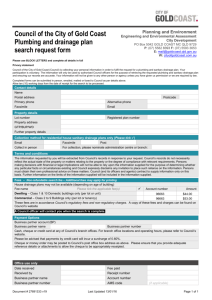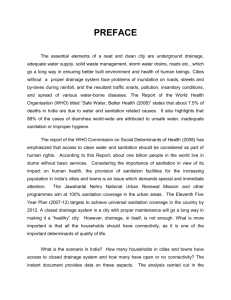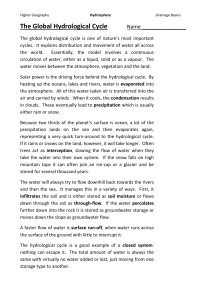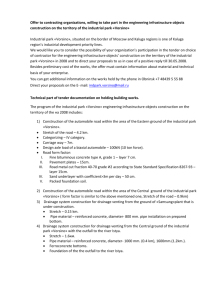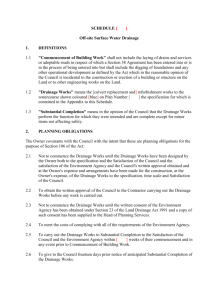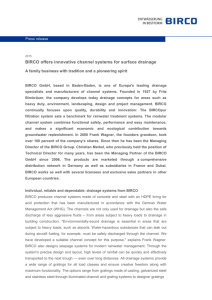DR1_HO_Participants Notes
advertisement
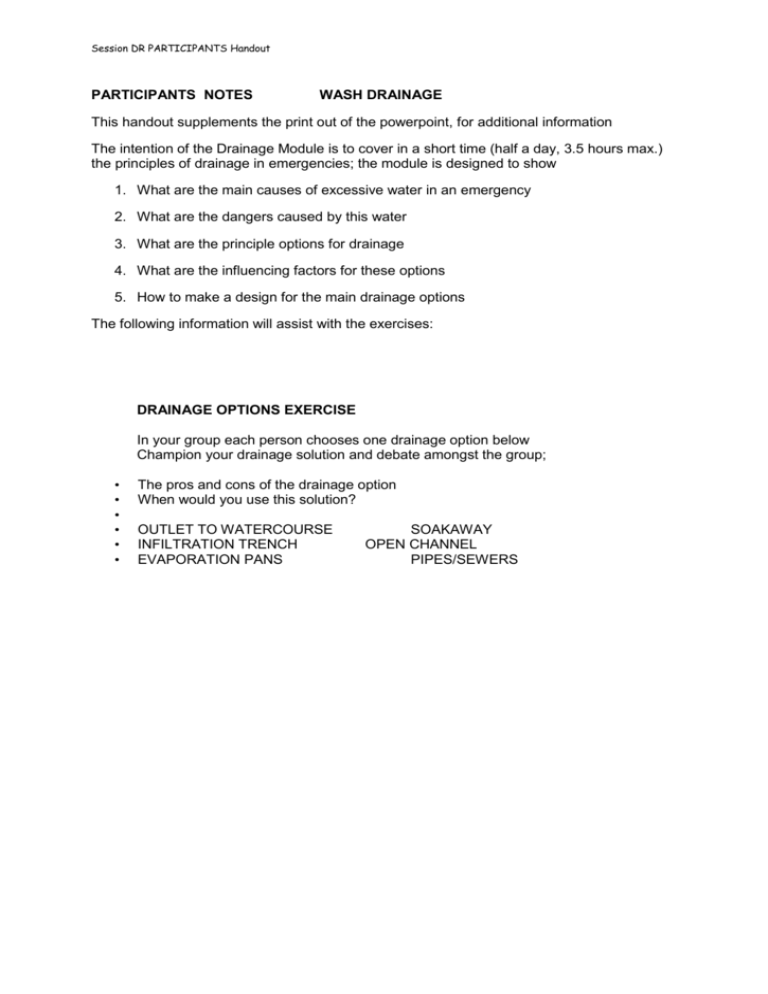
Session DR PARTICIPANTS Handout PARTICIPANTS NOTES WASH DRAINAGE This handout supplements the print out of the powerpoint, for additional information The intention of the Drainage Module is to cover in a short time (half a day, 3.5 hours max.) the principles of drainage in emergencies; the module is designed to show 1. What are the main causes of excessive water in an emergency 2. What are the dangers caused by this water 3. What are the principle options for drainage 4. What are the influencing factors for these options 5. How to make a design for the main drainage options The following information will assist with the exercises: DRAINAGE OPTIONS EXERCISE In your group each person chooses one drainage option below Champion your drainage solution and debate amongst the group; • • • • • • The pros and cons of the drainage option When would you use this solution? OUTLET TO WATERCOURSE INFILTRATION TRENCH EVAPORATION PANS SOAKAWAY OPEN CHANNEL PIPES/SEWERS Session DR PARTICIPANTS Handout SOAKAWAY DESIGN EXERCISE Task: Calculate the dimensions of a soakaway pit to drain wastewater from a communal shower area. A. In your groups, list the information you need to be able to do the calculation B. Make your assessment (ask your trainer the questions) C. Perform the calculation Wastewater drainage infiltration rates in different soils Infiltration rate (l/m2/day or mm/day) Soil type Description Clean water Wastewater 1,500 – 2,400 50 Moist soil sticks together but will not form a ball 720 – 1500 33 Loamy sand and sand Moist soil forms a ball but still feels gritty when rubbed between fingers 480 – 720 24 Loam, porous silt loam Moist soil forms a ball which easily deforms and feels smooth between fingers 240 – 480 18 Silty clay loam and clay loam Moist soil forms a strong ball which smears when rubbed but does not go shiny 120 – 240 8 Clay Moist soil moulds like plasticene and feels very sticky when wetter Gravel, coarse and medium sand Moist soil will not stick together Fine and loamy sand 24 – 20 Unsuitable for infiltration systems From Reed R, Dean PT (1994). Recommended methods for the disposal of sanitary wastes from temporary field medical facilities. Disasters 18:4. (Table 4.3 in Harvey, Bahri & Reed 2002) Session DR PARTICIPANTS Handout CASE STUDIES SCENARIO 1: • A site has been selected for 40,000 refugees who have crossed a mountainous border in Eastern Europe. The refugees are fleeing ethnic persecution and although many normally have a reasonable standard of living in cities have had to make long arduous walks across the mountains, carrying all their possessions. Some are from rural areas and carry stoves and some food. • The area has cold (-20o C) and snowy winters are followed by spring rains and hot summers. It is April and the camp is being prepared for the imminent arrival of the refugees in a few days. • The site is on the edge of a wide river valley, a large river flows through the valley floor, the valley is mainly used for farming, on the edge of the river plain is an existing village which uses shallow wells as a water supply. The proposed camp lies just above the village, at the foot of a steep mountain chain, the camp is situated about 40m in height above the river, the awesome rocks of the mountain rise above a steeply sloping naturally wooded area which is above the camp. • The soil in the valley is rich alluvium clay, where the camp is it is rocky, as the site was formerly a municipal refuse (garbage) dump for building and non hazardous materials, it is recently been used for sheep herding. Under the surface is fissured and fractured limestone with dry ephemeral (sometimes flowing) stream valley on either side of the site. • Assume all other standard camp services are met by other agencies, apart from fuel for cooking which is being discussed. The camp is being planned with a typical services for a high profile emergency such as road systems, hospitals, schools, kitchens, warehouse, tents, it is steep at 1:10 (10%) slope. Agencies can be supported by International forces with extensive range of vehicles, machines and gravel. • Make a preliminary drainage strategy, make reasonable assumptions if the information is not to hand, be prepared to present your plan and assumptions. What are the most likely drainage problems, what do you propose as the solutions? Session DR PARTICIPANTS Handout SCENARIO 2: Following a devastating earthquake in the Caribbean early in the year. Numbers of casualties and those affected were estimated to be 1.2m families homeless and 230,000 deaths. The worst affected areas included the capital itself, A revised Emergency Appeal was issued to assist 80,000 families living in self settled camps within the capital. 12,000 people have self settled a piece of wasteland behind a car dealership. They have organised themselves with an elected committee and zone representatives. The site is very compact with self made shelters squashed together with minimal free space. Pit Latrines have been constructed revealing a variety of soil profiles; broken down garbage, mixed loam, sand and clay. The latrine on the highest point encountered water at 1m deep, but this appears to be a localised problem or a burst water main. The climate is exceptionally hot and humid, dust still lingers in the air after the earthquake with danger of aftershocks, an intense rainy season is expected shortly to arrive in May, in late summer the region is often hit by severe hurricanes. An existing surface water drainage pipe (buried, 1m diameter) crosses the site, some manholes have open grates leading to this pipe. The vast piles of garbage lying in the site are being regularly cleaned away. Make a preliminary drainage strategy, make reasonable assumptions if the information is not to hand, be prepared to present your plan and assumptions. What are the most likely drainage problems, what do you propose as the solutions? Session DR PARTICIPANTS Handout Reference List Adams J. (1999) Managing Water Supply and Sanitation in Emergencies, Chapter 12, Oxfam Publications GB, Oxford Davis J. and Lambert R. (2002) Engineering in Emergencies: A practical guide for relief workers, Chapter 8, ITDG, London Sphere Project: (2004) Humanitarian Charter and minimum standards in disaster response, chapter 2, section 6 Drainage, Appendix 1 section 6 Drainage, Oxfam Publishing WHO (1991) Surface Water Drainage for Low-income countries, Geneva: World Health Organisation Corsellis T and Vitale A (2005) Oxfam Publishing Transitional settlement for displaced populations,


